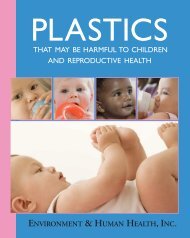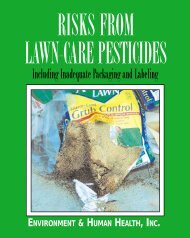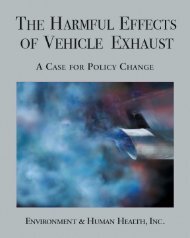LEED Report - Environment & Human Health, Inc.
LEED Report - Environment & Human Health, Inc.
LEED Report - Environment & Human Health, Inc.
- No tags were found...
Create successful ePaper yourself
Turn your PDF publications into a flip-book with our unique Google optimized e-Paper software.
The Green Building Debate<strong>LEED</strong>-certified buildings. The passage of laws that simply adopt <strong>LEED</strong>’sstandards by reference has become so commonplace that the passageof truly health-protective building laws will soon be extremely difficult.As described in the previous section on indoor chemical hazards, <strong>LEED</strong>’srequirement for compliance with federal, state and local environmentallaws similarly offers insufficient protection, given the limitations of theClean Air Act, Safe Drinking Water Act, federal pesticide law and theToxic Substances Control Act.Hazardous Chemicals in <strong>Human</strong>Tissues and Indoor <strong>Environment</strong>sTens of thousands of chemicals are traded in international commerce,most of them unregulated. Many chemicals enter indoor environmentsas ingredients in building materials, furnishings, insulation, electricalconduits, plastic piping, sealants, floor covering, plastic mats, solvents,adhesives, paints, preservatives, pesticides and consumer products.Many hazardous chemicals have been detected in human tissues,providing proof of environmental exposures. The National <strong>Health</strong> andNutrition Examination Survey (NHANES) analysis of hazardous chemicalsin human tissues is conducted periodically by the Centers for DiseaseControl and Prevention (CDC). This effort, begun in 1999, documentswidespread exposure to commonly used industrial chemicals.The passage of laws thatsimply adopt <strong>LEED</strong>’sstandards by reference hasbecome so commonplacethat the passage oftruly health-protectivebuilding laws will soonbe extremely difficult.The CDC’s findings reflect the increasing chemical complexity of indoorenvironments and the fact that Americans, on average, spend most oftheir time indoors. The CDC’s 2009 assessment of human exposure tochemicals measured more than 200 chemicals in 2,500 participants.Chemicals used in building materials—and also detected in humantissues—include BPA, metals, VOCs, PBDEs, PFOAs, pesticides, phthalatesand dioxins, all recognized as toxic substances. 1Carcinogenic and endocrine-disrupting pesticides were detected in morethan 50 percent of those tested. 2 The CDC’s findings demonstrate47







